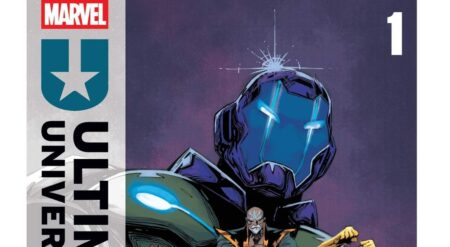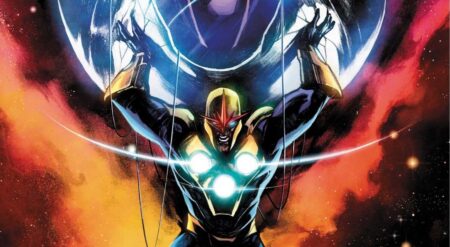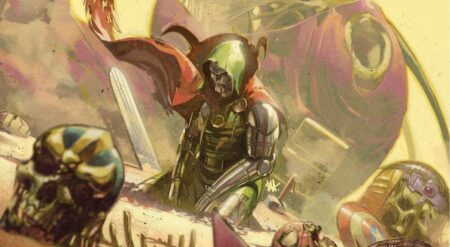Blood Hunt #4 is published by Marvel Comics, written by Jed MacKay, art by Pepe Larazz, colors by Marte Gracia and letters by Cory Petit. This is the penultimate issue of the Blood Hunt event. The truth around Blade is revealed as the heroes make dark alliances.
The main book of this event is largely served as a metronome, opening doors for tie-ins and sending them out on their individual missions. But it is in this core issue that the most prominent truths are revealed. The groups are separated, building dangerous allegiances that might be crucial to saving the planet.
For Doctor Strange and Clea, that journey takes them to Latveria, where Doctor Doom has kept his people safe from vampiric invaders. Tigra and Hunter’s Moon head for Asgard with a villain in tow, which is a surprising reveal at the end of the issue. The dark, mystical, menace has hung over the event from the start. However, the main book of Blood Hunt struggles to move with any real purpose. Bogged down in exposition, the pacing suffers.
The scenes have little connection, and the transitions are stuttering. The various sub-plots feel like their own stories instead of a greater event. Hints have been made towards Blade’s true identity in books such as Black Panther: Blood Hunt #2. However, this issue has lurched forward in time and spoiled the ending of that tie-in before it’s release. Blood Hunt #4 finds its intensity and its interest by the end of the book, especially as it paves the way for the final part of the crossover.
The characters in this book haven’t been able to excel together due to the disjointed storytelling, but they are strong enough to exude power in any scene. The two most significant examples of that are Blade and Doctor Doom. Doom has appeared elsewhere in the crossover, with multiple heroes trying to receive his aid. The confidence Doom has is what makes him a threat. There is always the notion that he has had plans for years. When he offers to help, there are always ulterior motives. And yet, despite his nefarious qualities, the man has ensured that his people are safe whilst the rest of the world burns.
As for Blade, the darkness within him spills over and officially makes itself known in this penultimate chapter. His glee towards murder and his ease in controlling enormous personalities, namely Black Panther, have made him a severe threat. But that danger has not been used to its full potential yet, and the awkward narrative structure has stopped his plan from instilling any real feeling of dread.
The cast includes a collection of characters from McKay’s ongoing series, from The Avengers to Doctor Strange to Moon Knight, and his supporting cast. Therefore, McKay knows the characters and their personalities. It has left huge absences of characters that are usually always present at these crucial moments. And those that are in the event lack the ferocity and presence to fill the void.
The art is the saving grace of this comic, with Larraz delivering some phenomenal pages. The locations and the settings are ominous as the entire world plunges into darkness. Even in 2024, the comic leans on the more medieval places of the world that a vampire invasion might be fitting. Asgard and Latveria have always embraced those designs, whilst some places in New York also feature Gothic architecture. The Avengers and heroes all look excellent, and the journey that they have been through across the event is present in their costumes.
The vampires are monstrous looking as their faces contort in furious rage and ravenous hunger. As Blade’s true identity becomes known, his physical self begins to break down. On the other side of the world, Doctor Strange’s audience with Doctor Doom features a villain who looks just as menacing as Blade. His eyes are almost always obscured in shadow, hiding his true intentions. But it doesn’t take much of a hunch to realise the Latverian ruler has his own game to play.
The colors are fascinating. Even within the darkness of a world without a sun, Gracia still tries to find light in every panel. It may be a magical source or flames from burning torches, but it adds beauty to the horror. As an ancient Atlantean temple sticks out of the New York City skyline, the purple and red glow that emanates from it is stunning. In Latveria, the green of Doom’s cloak brilliantly conflicts with the blue, red and gold of Doctor Strange. The lettering is clear and easy to read.
Blood Hunt #4 is too disjointed to land its most powerful punches. MacKay’s idea of spreading the event across the books affects individual issues. The art is excellent, and the dialogue has some bite to it, but the pacing and structure of the penultimate chapter zaps all of its energy. The book has limped along, trying to be everywhere simultaneously while ultimately going nowhere. Trying to follow the story requires understanding multiple books, and even then, the narrative stutters. The issue intensifies in the final pages, but no emotional connection to the event has already been severed.
Blood Hunt #4 is available where comics are sold.
Blood Hunt #4
TL;DR
Blood Hunt #4 is too disjointed to land its most powerful punches. MacKay’s idea of spreading the event across the books affects individual issues. The art is excellent, and the dialogue has some bite to it, but the pacing and structure of the penultimate chapter zaps all of its energy.








